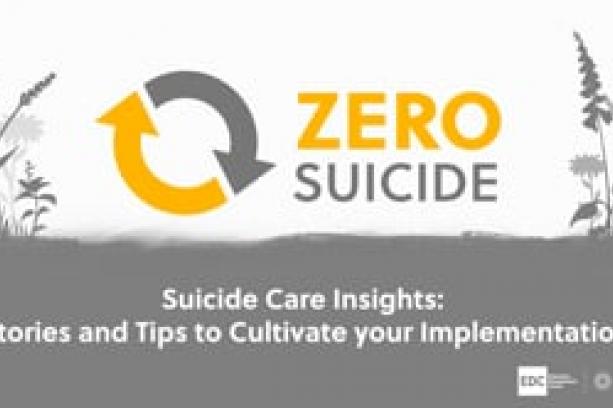Engage
Engaging Individuals at Risk
When an organization makes a commitment to Zero Suicide, every individual who is identified as being at risk for suicide is connected to collaborative care and support. They are engaged continually during every encounter through specific steps and interventions; this occurs regardless of the reason for the individual's visit.
This series of steps to maintain continuous engagement and ensure high-quality care is called a pathway to care.
The prioritization of a collaborative and engaging approach to safety is a core tenant of the Zero Suicide approach, ensuring that every individual at risk for suicide is an active participant in their own care. The Engage element emphasizes the simultaneous importance of evidence-based systems of support and individual autonomy and self-expertise.
In a Zero Suicide approach, Engage broadly refers to:
- A pathway to care that instills hope and is recovery focused
- Collaborative safety planning
- Counseling on access to lethal means
- The steps taken by providers to maintain the patient's engagement in, and commitment to, their care while working collaboratively with the individual
- Maintaining communication with the individual between appointments and during transitions
- The pathway is embedded and documented in an electronic health record
- Supporting healthcare workers who provide the care for individuals at risk of suicide
Providers and Processes
The success of the care delivered to individuals at risk for suicide in the Treat and Transition elements of the Zero Suicide framework relies heavily on the work done by providers within the Engage element. The efforts put forth by providers to provide collaborative, compassionate, and evidence-based care create an environment in which the individual feels their voice is heard, they are cared for, and they are supported and empowered in getting their needs met during their care and recovery.
Organizations that have reported the most success in providing individuals with a pathway to care use the electronic health record (EHR) to flag individuals at risk of suicide so that providers are aware of the potential need for additional support around suicide risk.
By using the EHR, care becomes more streamlined and consistent, and the frequency with which individuals must start from the beginning with providers or organizations is decreased; the provider and individual are on the same page and know what to expect. Within the EHR, a provider can find information related to the individual's risk, information on their safety plan, and other providers who are part of the care team.
Questions
What is our approach to following the care of individuals at risk for suicide?
How will we provide care that engages individuals at risk of suicide and empowers them in their recovery?
How are those with lived experience engaged in the process of establishing collaborative engagement practices?
What formal review processes will be implemented to ensure individuals have felt engaged, heard, and empowered?
Design Suicide Care Management Guidelines
Design guidelines for engaging a patient in a pathway to care, which should specify the following:
- The screening tool and criteria to indicate that the individual should be engaged in a pathway to care
- Provision of same-day access to a behavioral health professional for formulation of a clinical judgment of risk using a standard risk formulation framework
- Requirements and protocols for safety planning, crisis support planning, and lethal means safety
- The frequency of visits for a patient on a suicide care pathway
- Actions for the provider and system to take when an individual misses an appointment or stops engaging in care as well as educating individuals on those steps
- The process for communicating with an individual about their diagnosis, treatment expectations, and what it means to be on a suicide care pathway
- Parameters for continued contact with and support for the individual, especially during transitions in care
- The referral process to suicide-specific, evidence-based interventions
- How documentation of progress and symptom reduction will take place
- Criteria and protocols for closing out the suicide care pathway when an individual is ready
Implement Suicide Care Management Policies
Change systems and get staff buy-in so that policies will be followed by:
- Establishing use of the EHR to monitor individuals in a pathway to care
- Training all staff in use of the relevant features of your EHR related to the care pathway (e.g., assessments, safety plans, ways to ensure warm handoffs, caring contacts)
- In the absence of an EHR, ensuring all staff clearly document individual status and updates in the paper record
- Training staff on discussing the meaning of a pathway with individuals who are placed on one, as well as what the individual can expect moving forward with special emphasis on engaging and instilling hope
- Training all staff at least annually in your organization's care pathway guidelines and protocols so they know what is expected of them, the philosophy behind these policies, and how they will be supported by the system
- Establishing a schedule for regular team meetings and clinical case consultations to discuss individuals at risk.
- Setting a schedule for management to regularly review charts to determine that policies and protocols are being followed not just in letter, but also in the spirit of instilling hope
Implementing these suicide care management policies can be supported by using your electronic health record (EHR) and many systems have found the EHR to be a key factor in constantly engaging individuals at risk for suicide in a pathway to care.
Healthcare Worker Wellness
Health and behavioral healthcare workers are experiencing burnout at high rates and organizations have to develop ways to support their workforce so they can provide the needed care to those individuals at risk of suicide. There are many toolkits and recommendations from government and non-government agencies like the U.S. Surgeon General, SAMHSA, the World Health Organization, Institute for Healthcare Improvement, and the American Medical Association. All of these, and more, can be found in the resource section of this toolkit.
Rationale for EHRs
Health and behavioral health organizations should take steps to ensure that a patient’s suicide risk is reviewed at each visit and that care is coordinated and communicated between the patient and professionals within and outside of the organization.
Building the capacity to follow the care of patients at risk in an electronic health record (EHR) system can help ensure that care is continuously, consistently, and deliberately provided by all involved to address suicide risk. However, not all organizations have a comprehensive EHR system. Nevertheless, every organization should attempt to record suicide screening results, risk formulation, and suicide-specific care plans in each patient’s record. Paper records should be reviewed periodically to ensure that suicide risk is being assessed and recorded by each staff member designated to do so.
Implementer Example
The Institute for Family Health (IFH) is one organization at the forefront of using the EHR in service of a Zero Suicide initiative and providing safer suicide care. Perhaps the most important advice from IFH’s experience is to include someone from the organization’s information technology (IT) department on the Zero Suicide implementation team from the very beginning. Involving an individual from the IT department of your organization will make sure that you are informed about what is possible and are able to create buy-in within the department as you work together closely to build out the EHR in such a way that the care pathway can be integrated and easily accessible.
The video below describes how IFH modified their EHR to support better safer suicide care management.
Engaging with Individuals via Telehealth
Telehealth has become a vital part of the health and behavioral healthcare service delivery system. For many providers accustomed to face-to-face patient interactions, there may be questions about the best way to engage with patients via the telephone and/or video contacts. Some individuals may prefer telehealth visits for several reasons, ranging from those related to personal comfort to those having logistical concerns. There are many ways to provide excellent and compassionate ongoing care via telehealth that allow the provider to screen and assess for suicide risk, collaborative create safety plans, provide counseling on access to lethal means, and provide urgent care to those who require it. We have many resources available to providers regarding providing various aspects of care via telehealth by visiting the Telehealth section of the Providing Suicide Care During Covid-19 page.
Watch the video below for a short video about how one Brave Health clinician overcame their fears about telehealth.

